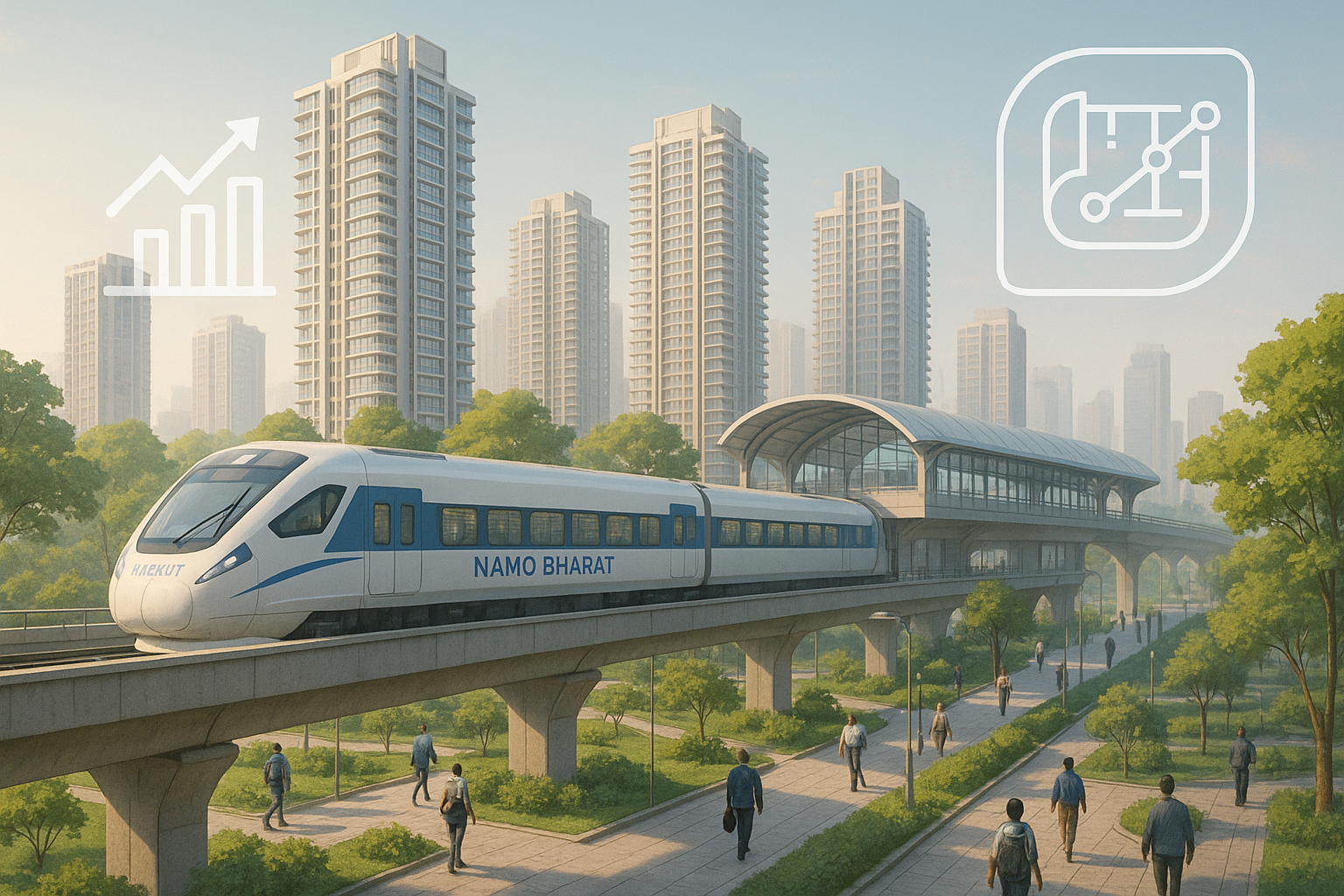Meerut Leads India’s Transit‑Oriented Development Drive
Meerut is setting new standards in urban planning. It’s India’s first city to officially embed Transit-Oriented Development (TOD) into its 2031 Master Plan devoting 3,273 hectares for development around Namo Bharat and the upcoming Meerut Metro. That’s not just forward thinking it’s a real estate wake-up call.
What Tod Zoning Means for You
TOD is all about creating walkable, mixed-use hubs close to high-frequency transit. Here’s what’s included in Meerut’s strategy:
- Seven TOD zones and two Special Development Areas focused on stations like Meerut South, Shatabdi Nagar & Modipuram.
- Residential, commercial, office, and public space integrated within 500m of metro and up to 1.5 km of high-speed transit .
- Higher FAR expansion from 2.5 to 4–5 allowing taller, denser buildings.
The result? Walkable, vibrant neighbourhoods tapping into public transit efficiency just like in Tokyo, Copenhagen, or Singapore.
How Namo Bharat & Metro Stack Up
Meerut’s transit ecosystem is getting a major upgrade:
- The 82 km Namo Bharat RRTS corridor (Delhi–Meerut) is on track, with at least 55 km already in operation.
- The Meerut Metro adds 25 stations including four interchanges with Namo Bharat covering a 23 km stretch.
- Together, these systems enable seamless, high-speed regional and urban connectivity at up to 160 km/h.
That’s mobility on steroids and it’s a magnet for real estate growth.
Fueling Growth: Value‑Capture Financing & PMU Strategy
To make it sustainable, NCRTC is integrating TOD with value-capture financing monetizing land value gains around stations.
- 300 hectares earmarked for private township auctions.
- A Project Management Unit (PMU) scouting bids and crafting development plans for retail, offices, rentals, health services, and entertainment hubs near stations.
This funding model keeps development rolling without burdening taxpayers.
What This Means for Meerut’s Real Estate Market
- Residential Boom: Happy homeowners will be those within walking distance to transit, mixed-use malls, and offices.
- Commercial Zones Thrive: Retail, co-working hubs, F&B outlets, and service centers will flourish around busy stations.
- Integrated Townships Rise: Developers can now envision complete live-work-play ecosystems think malls on the ground, offices in towers, homes above.
- Rental Premiums Climb: Expect higher yields and faster occupancy in TOD-linked properties.
Basically, TOD isn’t just buzzword it’s a real profit engine.
Meerut: A Global Template
Meerut’s TOD-first approach mirrors successful models in Stockholm, Hong Kong, and Tokyo. The National Metro Rail Policy 2017 warned us to see metro corridors as drivers of urban transformation not merely transit. Meerut has taken this seriously and the rest of India should take note.
Smart Investment Moves: What to Do Now
- Scope Station Proximity Deals
Properties within 500 m of transit lines? Primary pick. This is where real returns will show. - Track Farmland Auctions
With 300 ha tagged for auction, early entry could yield high-value plots. - Watch PMU Announcements
Those tender notices and bids clue you in on priority development zones. - Pad Your Portfolio Strategically
Include TOD-aligned assets residential, rentals, retail all in one entry.
The Takeaway
Meerut’s leap into transit-centric planning, its embrace of TOD, value-capture financing, and integrated rail systems are a real estate masterstroke. The 2031 Master Plan isn’t just an urban blueprint it’s a real-life investment opportunity. When land, transit, and development align magic happens.
For investors, developers, and homebuyers, it’s time to think smart, act early, and ride this wave.
FAQs for EstateBrief Readers
Q1: What exactly is Transit-Oriented Development?
TOD is the strategic building of mixed-use, walkable urban nodes close to high-frequency public transit.
Q2: How does value-capture financing help?
It recovers land value uplift near transit nodes to fund infrastructure keeping projects financially stable while boosting value.
Q3: Why is FAR increase important?
Higher FAR allows taller buildings, translating into greater density, value, and developer ROI.
Q4: When does the full corridor become operational?
The Delhi–Meerut RRTS final phase completes by June 2025, with Meerut Metro rolling out concurrently.
Q5: Should I invest now or wait?
Now is ideal for prizes that ride growth curves. Station-area property generally sees the sharpest appreciation post-launch.
Meerut isn’t just evolving it’s aiming to lead India’s next wave of smart, sustainable, transit-driven urban growth. And that’s the kind of story that lets real estate savvy speak through action.




